Top 10 Hottest Fashion Marketplaces of 2024
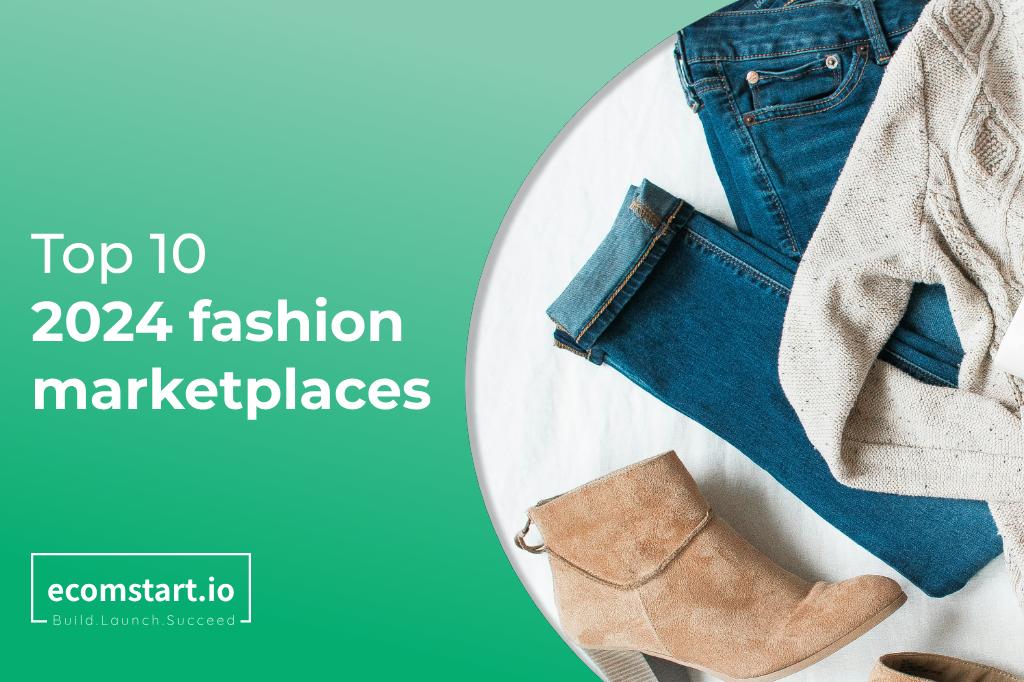
Selecting the right online fashion marketplaces to showcase specific products from their catalog can greatly enhance sales for merchants, making it a highly advantageous strategy. According to a global survey, 70% of customers consider marketplaces to be the most convenient method to buy, and 66% prefer sites that provide them.
Using online fashion marketplaces not only allows sellers to reach numerous customers and increase their online sales, but it also improves brand awareness and automates inventory management. To help merchants expand their online business, we’ve compiled a thorough list of the best 10 eCommerce marketplaces designed specifically for fashion and textile producers.
1. Top 10 Best Online Fashion Marketplaces: An Overview
Let’s take a look at the overview of the 10 best online marketplaces for sellers to sell clothes that any merchants should know:
| Marketplace | Niche | Monthly visit | Seller fees |
| Amazon | A vast marketplace with a diverse customer base. | 2.4 billion | Monthly fee: $39.99/ month. Referral fee for each sold item; the percentage varies between 6% to 45%. |
| Etsy | Focuses on handmade, vintage, and unique products. | 479 million | Charge a 6.5% transaction fee for each sale. |
| Poshmark | Specializes in secondhand and pre-owned clothing, shoes, and accessories | 61 million | For all sales under $15, charge $2.95 (flat commission)For sales of $15 or more, charge 20% of your sales. |
| ASOS | Offers a wide range of trendy and affordable clothing, accessories, and beauty products. | 69.8 million | 20% commission on sales |
| Farfetch | An online luxury fashion marketplace that connects shoppers with independent boutiques and luxury brands. | 28.1 million | 30% commission from each sale |
| Depop | Fashion marketplace that combines elements of social media and eCommerce, focuses on unique, vintage, and trendy fashion items. | 13.1 million | 10% commission on the total transaction amount (including shipping costs). |
| Vinted | Focuses on secondhand clothing, shoes, and accessories and promotes sustainable fashion practices. | 94.6 million | Vinted primarily charges fees to buyers but no fee for the sellers. |
| Zalando | Provide a wide range of fashion products for men, women, and children. | 144.1 million | 5% – 25% commission on each sold product. |
| JOOR | a B2B fashion marketplace that connects fashion brands and retailers | 81.3 thousand | 3% commission from each sale |
| Spartoo | An online footwear retailer that focuses on shoes for men, women, and children | 5.9 million | Monthly fee: 39 euros/ month (excluding VAT) Commission fee: 15% for multi-brands and 20% for mono-brands |

2. What’s an online fashion marketplace?
An online fashion marketplace is a digital platform where people and businesses can buy and sell fashion-related items. As a centralized hub, it allows for the interaction between sellers and buyers, allowing them to engage, discover, and deal online. These marketplaces often provide a wide range of fashion products, including apparel, accessories, footwear, and more, providing fashion lovers with a fast and diversified buying experience.
2.1. Types of online marketplaces
Global Marketplaces
Global marketplaces are online platforms that connect buyers and sellers from around the world, enabling international trade and commerce. Buyers and sellers can conduct transactions across borders and offer a wide range of products and services on a global scale. Think of Amazon, a renowned example of a global marketplace that offers a vast array of products and allows sellers from different countries to reach a global customer base.
Local Marketplaces
Online marketplaces that operate within a specific geographic area or community are known as local marketplaces. These platforms are designed to meet the unique needs and preferences of the local population, promoting local commerce and providing support to local businesses. Take a look at Craigslist to gain a better understanding of how local markets function. Craigslist is a widely used local marketplace that enables users to purchase and sell various items, discover job opportunities, rent properties, and connect with local services in their particular region.

Vertical Marketplaces
Vertical marketplaces also referred to as niche marketplaces, are digital platforms that cater to specific products or services within a particular industry or vertical. These platforms offer a focused marketplace for buyers and sellers with specific interests or requirements. Take Houzz, for instance, a vertical marketplace that concentrates on home improvement and interior design. It links homeowners with professionals in the field and presents a handpicked assortment of products and services related to home decor and renovation.
Horizontal Marketplaces
Horizontal marketplaces are digital platforms that offer a broad array of products and services spanning various categories. Serving as a convenient hub, these marketplaces address the diverse needs of consumers and offer a wide selection of items. eBay, a well-known horizontal marketplace, exemplifies this concept by providing individuals and businesses with the opportunity to engage in buying and selling a vast range of products, including electronics, fashion, collectibles, and more. With its extensive offerings, eBay ensures that it caters to a wide audience and presents a plethora of choices.
2.2. What’s different between the fashion marketplace and fashion eCommerce platform?
The primary difference between eCommerce platforms and marketplaces lies in how they handle transactions between customers and vendors.
Marketplaces, also referred to as managed platforms, offer a comprehensive experience that includes managed payments and delivery services. Their main focus is on connecting buyers and vendors, providing greater flexibility and less control over the final purchase.
To explain further, an online fashion marketplace typically has full control over financial transactions and provides end-to-end user experiences and business facilitation for both vendors and customers. Imagine an online fashion marketplace as a department store, where various suppliers showcase their products within a shared space and are sold under shared rules at the store’s checkout.
On the other hand, eCommerce platforms are more akin to thrift markets, where customers move from one vendor to another and interact with each one individually. While market administrators vet every seller, vendors operate independently in terms of their sales processes and other operations.

2.3. Pros & cons of selling clothes on the marketplace
The benefits of participating in clothing marketplaces can differ across countries and markets, as well as between buyers and sellers. By utilizing a reputable eCommerce marketplace, merchants can approach a wide range of customers and distribute to the target customers with low-budget marketing. Moreover, selling on these popular marketplaces helps build trust and credibility, as customers inherently trust brands that sell on these platforms.
Selling on fashion marketplaces online can greatly reduce the amount of effort required, thanks to the exceptional customer service provided by these platforms, which includes round-the-clock support. This effectively eliminates the burden of managing after-sales services, such as returns, exchanges, and delivery payments, as these tasks are taken care of by the marketplaces themselves.
However, it is important to consider the potential drawbacks of clothing marketplaces. While there is minimal upfront cost, these platforms charge specific fees for each sale, which can vary depending on factors such as the location of your business or the type of products you offer. Additionally, marketplace limitations may restrict your ability to brand your online presence as desired, and certain terms and conditions must be followed, particularly regarding customer communication and return/refund policies.
3. Top 10 fashion marketplaces to sell in 2024
3.1. Amazon
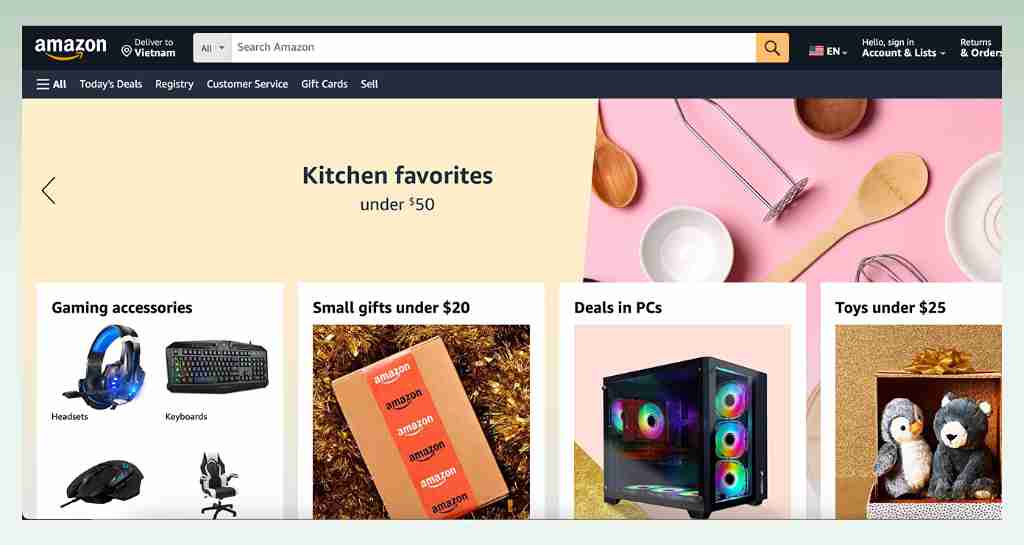
Amazon, a well-known eCommerce marketplace, holds a significant position in the global retail market. It represents around 50% of the total gross merchandise value (GMV) and attracts 2.4 billion potential buyers in the US and 372 million in the UK every month, making it an ideal platform for online merchants. In the year 2022, Amazon achieved a total sales figure of $514 billion, which reflects a 10% increase compared to the previous year.
Selling on Amazon provides sellers with various advantageous features. Its global reach allows access to a wide customer base across different countries and regions. Besides, the Fulfillment by Amazon (FBA) program enables sellers to store their inventory in Amazon’s fulfillment centers, taking care of storage, shipping, and customer service. FBA also allows sellers to make their products eligible for Amazon Prime, which offers fast and free shipping to customers.
Amazon sellers can access advertising tools like Sponsored Products and Sponsored Brands to enhance the visibility of products. The Seller Central Dashboard serves as a centralized hub for inventory management, sales monitoring, shipment tracking, and performance metrics. Not only that, when rolling in Amazon’s Brand Registry program, sellers can safeguard their brand based on intellectual property rights. Additionally, Amazon offers inventory management tools to facilitate efficient restocking and sales analysis.
The benefits of selling on Amazon include access to a vast customer base, the convenience of FBA services, and increased online presence and sales. However, sellers should also consider the potential drawbacks of Amazon, such as fees that may impact profitability and limited access to certain activities.
3.2. Etsy
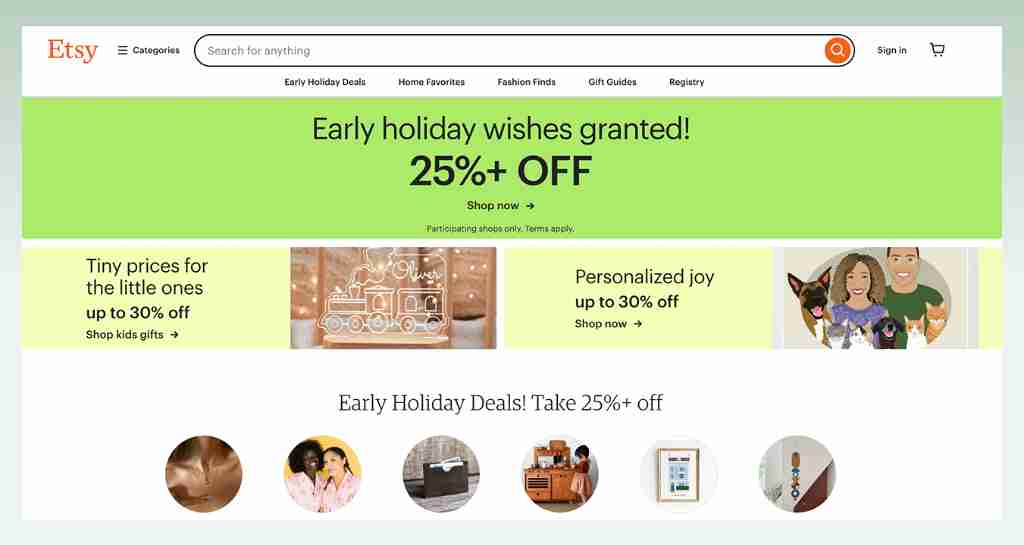
Etsy is the best site to sell clothes and focuses on handcrafted, vintage, and creative goods. It is one of the largest markets in the United States, with nearly 5 million monthly visits. The marketplace’s gross merchandise sales (GMS) reached $13.34 billion in 2022, with an income of $2.566 million, a small decline from the previous year.
Etsy provides a variety of features for sellers, such as shop appearance customization, Direct Checkout for secure payments, international selling capabilities, a Seller Dashboard for inventory management and analytics, promotional tools for effective marketing, and seller protection policies.
Selling on Etsy allows access to an online marketplace recognized for its unique items, an enormous consumer base, and user-friendly tools for expanding one’s business. One drawback of Etsy is the high level of competition, with a rising number of merchants looking for attention.
To make sure that your business is successful, you should consider some factors when deciding to sell on Etsy, as it provides a distinct marketplace for creative and handmade goods but also poses challenges due to the competitive environment.
3.3. Poshmark

Poshmark is one of the most outstanding clothing marketplaces that specializes in fashion and clothing, providing a unique platform for both buyers and sellers. With 61 million potential customers, Poshmark has created a bustling community centered around fashion enthusiasts. The platform’s impressive annual gross merchandise sales of $1.8 billion in GMV in 2021 highlight its success and popularity among fashion-conscious consumers. In the third quarter of 2022, Poshmark reached revenues of $88.4 million, up 11% from the third quarter of 2021. Gross Merchandise Value (GMV) grew 7% to $475.6 million.
When opening a store on Poshmark, sellers will access innovative features including the opportunity to construct virtual “closets” to exhibit their goods and flair. Through social commerce, the platform also develops a feeling of community by enabling merchants to connect with consumers through sharing, commenting, and following, which may successfully market their items.
Thanks to Pormark, vendors can reach a specific demographic of fashion lovers, improving the probability of finding interested purchasers. The software also streamlines the payment process, assuring safe transactions and lowering seller effort. Furthermore, the social feature of the site helps vendors create relationships with buyers and a dedicated consumer base.
However, Poshmark does have some limitations. The competitive nature of the marketplace can make it challenging for sellers to gain visibility and stand out among numerous listings. This fashion marketplace also charges fees on each sale, which can impact sellers’ profitability.
3.4. ASOS
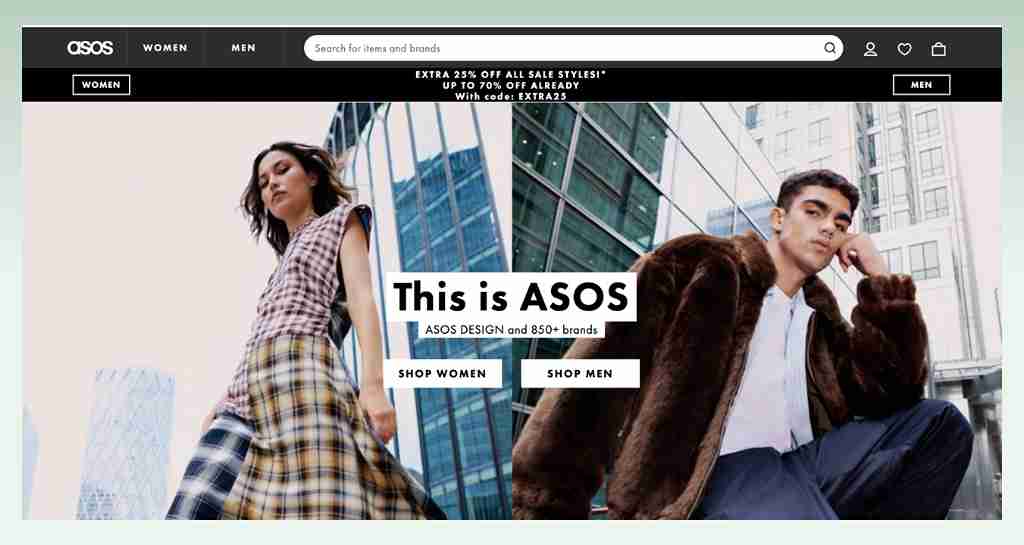
ASOS is considered the best online marketplace to sell clothes with a wide customer base. With 69.8 million traffic each month and 23 million active customers worldwide, including 7.1 million in the UK, ASOS has become a prominent player in the industry. The company’s annual gross profit reached £1.7 billion in 2022, highlighting its success and financial strength.
Different from big marketplaces, ASOS focuses on fashion and stands out by offering a diverse range of unique items, including its brand and products from independent labels and designers. This variety ensures that customers can find exclusive fashion pieces, setting ASOS apart from other retailers.
The platform also serves as a marketplace for sellers, providing them with a prominent platform to showcase their products to a large and engaged customer base. ASOS offers sellers a dedicated portal to manage their inventory, track sales, and access marketing tools, allowing them to enhance their visibility on the platform. This marketplace feature enables independent brands and designers to gain exposure and reach a broader audience.
Besides the remarkable advantages, there are some disadvantages that sellers have to know. The competition can be intense, requiring sellers to differentiate themselves and create a compelling brand presence. ASOS also charges fees and commissions on sales, impacting sellers’ profitability.
3.5. Farfetch
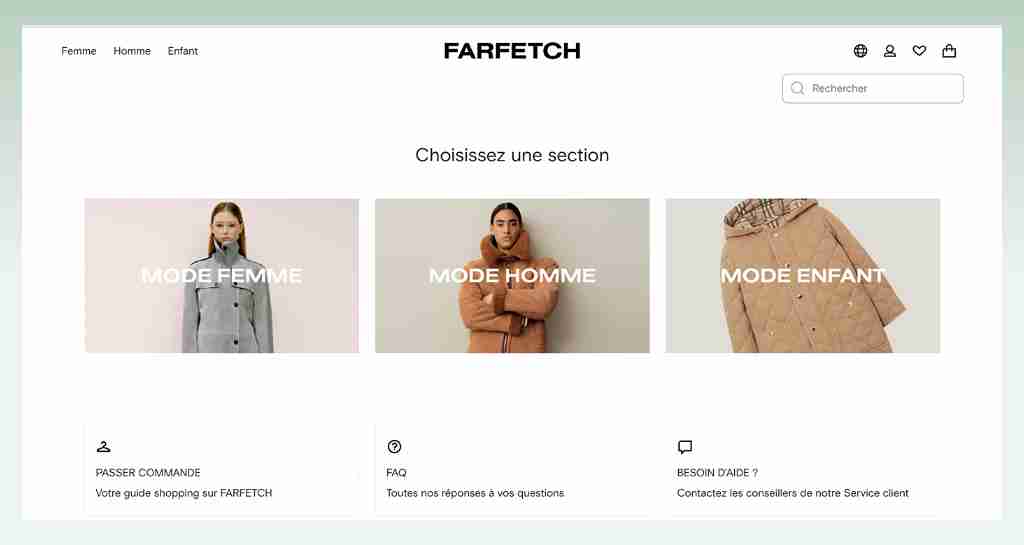
Farfetch is one of the best high-end clothing marketplaces, focused on clothing and beauty products, boasting access to over 750 renowned brands and boutiques. With an annual gross merchandise sales figure of $4.1 billion and a monthly traffic of nearly 20 million users, it’s clear that the platform has solidified its popularity among fashion enthusiasts worldwide. The platform connects customers in over 190 countries and territories with items from over 50 countries and over 1,400 of the world’s best brands, boutiques, and department stores.
In Farfetch, customers can explore a diverse range of exclusive fashion pieces, ensuring they stay on top of the latest trends. This extensive selection is a major draw for shoppers looking for sought-after inventory.
Serving as a marketplace for sellers, Farfetch provides them with a platform to showcase their products to a global audience. This feature enables sellers to expand their brand’s reach and visibility while also offering tools and resources to manage inventory, track sales, and enhance their presence on the platform.
Selling on Farfetch has several advantages, including access to a significant market of fashion-conscious consumers and the platform’s reputation in the industry, which instills trust and credibility. However, sellers should be aware of the intense competition and commission fees, which can impact profitability.
3.6. Depop

Depop has emerged as a thriving marketplace, connecting global buyers and sellers under one platform. With 1.8 million active sellers and over 30 million registered users, Depop offers a diverse and vibrant marketplace experience. Depop generated approximately $85 million in revenue in 2022, up 54.5% from 2021.
When publishing a store on Depop, sellers can take advantage of a straightforward setup process, enabling them to swiftly establish their online stores. Depop allows sellers to customize their listings, and communicate with potential buyers through direct messaging. With the integration of social media elements, the platform empowers sellers to showcase their products and cultivate a loyal fan base. Additionally, Depop provides tools for inventory management, order tracking, and analytics to help sellers optimize their sales strategies.
Despite its many benefits, Depop may occasionally experience interruptions in customer service. Due to the high volume of traffic and transactions on the platform, there may be times when customer inquiries or issues are not addressed promptly. However, it is worth noting that Depop is actively working to enhance its customer service and support systems to provide users with better assistance.
3.7. Vinted
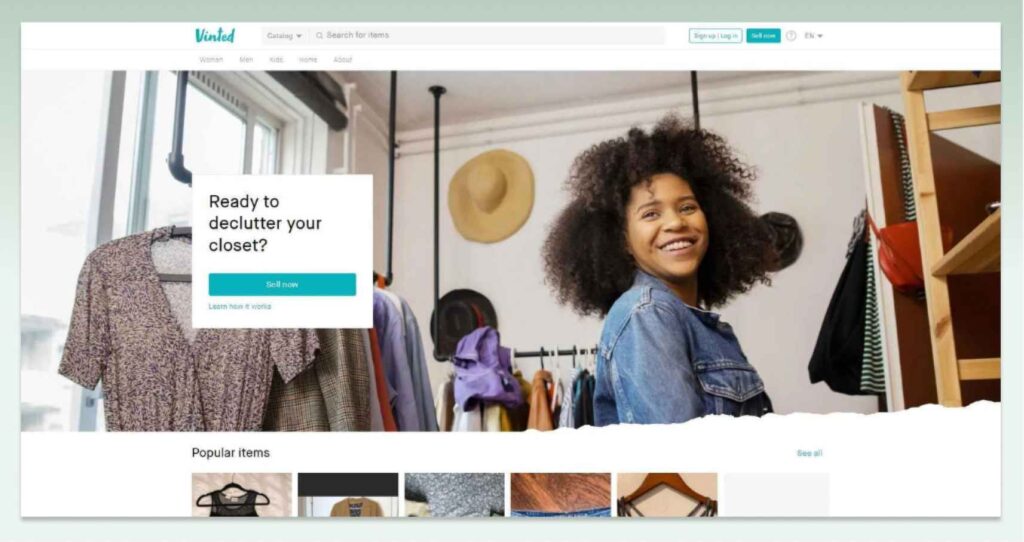
Vinted is one of the best fashion marketplaces in the second-hand fashion market, garnering an enormous user base of 75 million individuals. Considered as one of the best used clothing marketplaces, Vinted has experienced notable triumph, boasting revenue of over 371 million euros in 2022. Vinted’s nearly 6.5 million monthly visitors are a testament to its popularity among fashion aficionados.
Getting started with selling on Vinted is an effortless process. The platform offers a hassle-free experience, with an array of features that enable sellers to manage their listings with ease. These features include organizing, categorizing, and pricing items, as well as facilitating item swapping. Vinted’s unique approach to charging the buyers, instead of the sellers, eliminates upfront fees and ultimately benefits the sellers.
Vinted offers users the convenience of access through both iOS and Android applications, permitting sellers to easily oversee their listings and communicate with potential buyers while mobile. Despite the benefits of using Vinted, one disadvantage is the occasional dissatisfaction that buyers experience when receiving items that do not meet their expectations in terms of quality or condition. To prevent this issue and maintain customer satisfaction, sellers should prioritize providing detailed and accurate descriptions of their products.
3.8. Zalando

As a prominent online marketplace, Zalando has effectively captured a wide audience, encompassing both high-end and streetwear brands. Demonstrating an impressive growth rate of 3%, Zalando’s gross merchandise sales amounted to 14.8 billion euros in 2022, cementing its position as a key player in the fashion industry. Furthermore, the platform boasts a significant monthly traffic of 144.1 million users on every site in different countries, attesting to its widespread appeal among fashion-savvy consumers.
Zalando’s wide range of offerings, which include both streetwear and high fashion brands, is one of its biggest advantages. This diversity enables vendors to reach a wider customer base and showcase their goods to a vast audience. Zalando also provides comprehensive partner programs for sellers, which include support and resources to boost their presence on the platform. Moreover, the marketplace offers fulfillment solutions and logistics access, streamlining the selling process for vendors.
Though Zalando has strict policies in some areas, sellers should take care to learn these rules to avoid issues. By familiarizing themselves with the platform’s guidelines, sellers can make sure they comply with all requirements.
3.9. JOOR
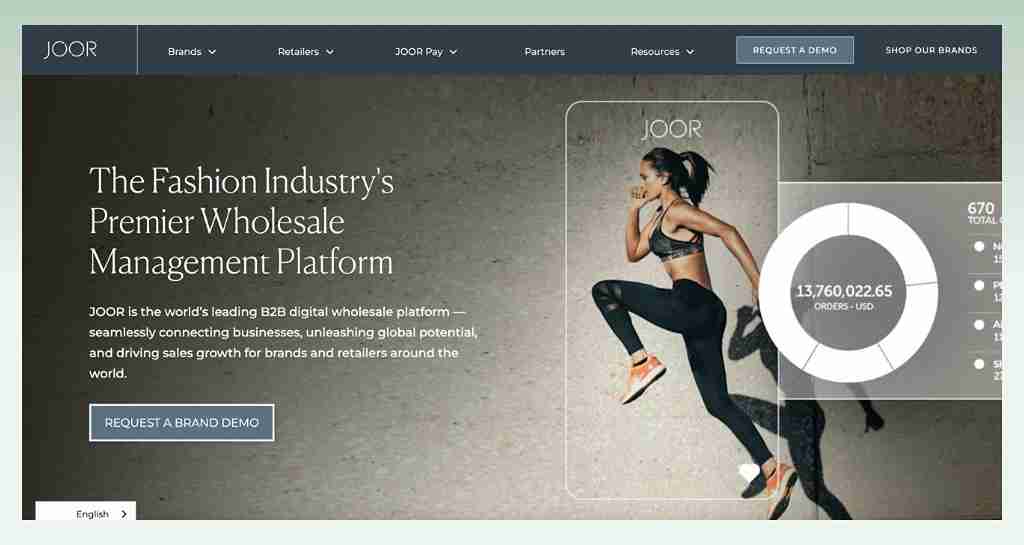
JOOR, a leading B2B fashion marketplace for wholesale fashion, serves as a vital link between buyers and sellers in the industry. With an impressive annual revenue of $36.9 million, JOOR has firmly established itself as a successful player in the B2B fashion realm. Its popularity and influence are evident through its ability to attract 2.3 million users.
One of the key advantages of JOOR lies in its seamless transaction facilitation between brands and retailers. Sellers have the opportunity to showcase their unique items to a vast network of buyers, thereby expanding their reach and increasing sales opportunities. This clothing wholesale marketplace goes above and beyond by providing sellers with comprehensive tools and features to effectively manage inventory, orders, and buyer communication.
Using JOOR provides sellers with access to a broad, diversified network of fashion shops, allowing them to enter new markets and build crucial relationships. Sellers can efficiently exhibit and sell their items because of the user-friendly interface and extensive features.
Nevertheless, the success of JOOR is strongly reliant on active engagement from both buyers and sellers. With so many brands to choose from, sellers may find it difficult to distinguish. a
3.10. Spartoo
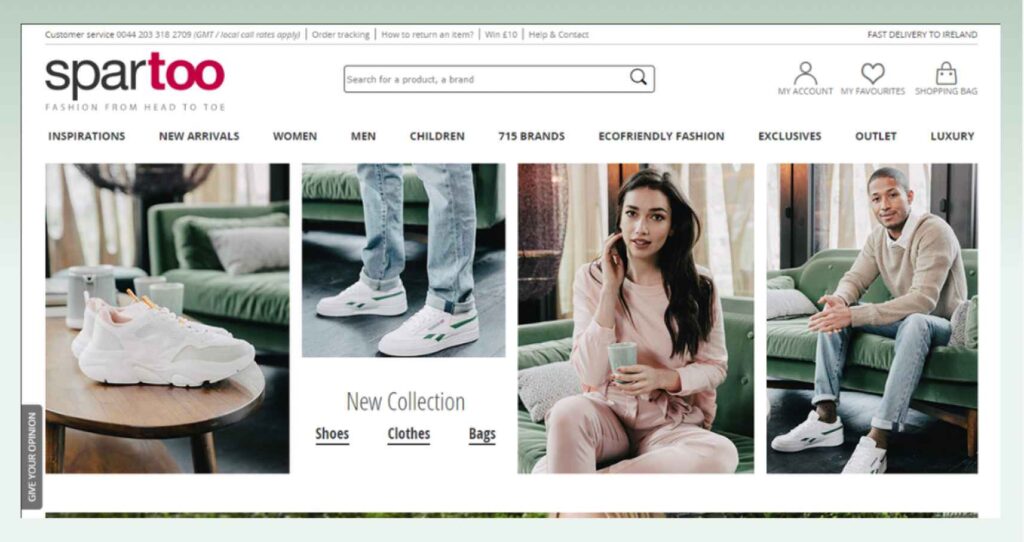
Spartoo is one of the top clothing online marketplaces for sellers renowned for its extensive collection of footwear and fashion items. Its brand awareness spans across major European countries like France, Germany, Italy, Spain, and the United Kingdom. Spartoo’s specialist marketplace attracts nearly 5.9 million unique visitors every month, who are usually well-informed and prepared to make purchases. Despite being a niche marketplace, Spartoo continues to grow rapidly, generating a revenue of 149.4 million euros in 2022 and establishing itself as a top contender in the industry.
By establishing a store on Spartoo, sellers can tap into a vast customer base, thereby broadening their reach and potentially increasing their sales. Spartoo’s emphasis on shoes and fashion guarantees that sellers operating within this niche will discover a focused audience. With plenty of integrations accessible, sellers should be able to link up with a variety of e-commerce and retail systems utilizing the API information that is provided. While phone and email support are available during typical UK office hours, Spartoo is not recommended for novices.
To be a seller on Spartoo’s platform, you must meet certain requirements as they have stringent criteria. The minimum number of Stock Keeping Units (SKUs) that a seller must have is 250. Additionally, sellers who do not have authorization from the brand owner may not be allowed to join. As the signup process may take several days or more, it is recommended that sellers obtain the brand owner’s permission before signing up to save time and ensure a smooth and prompt listing process.
4. How to sell items on fashion marketplaces with success?
4.1. Choose the right marketplace
If you want to be a successful seller, you have to clearly define your target audience and select a fashion marketplace that aligns with your target audience and the type of items you sell. You should consider factors such as user base, fees, and platform features and choose popular options including platforms like eBay, Etsy, Depop, and Poshmark.
4.2. High-quality visuals
To ensure that your customers trust you, make your store professional with high-quality product pictures that showcase your items in the best light. Clear, visually appealing visuals can attract potential buyers and increase their confidence in your products.
4.3. Competitive pricing
It is essential to ensure that it won’t make potential customers balk and leave. To achieve this, it is crucial to research similar items available in the market and set a competitive price. During this research, take into account factors such as brand, condition, and market demand. It is also wise to consider the possibility of periodic promotions or discounts to entice more customers to make purchases.
4.4. Provide exceptional customer service
It is important to respond promptly to any inquiries and provide precise information. In addition, maintaining professionalism and courteousness in all interactions with customers is essential. Timely and dependable shipping is vital in ensuring customer satisfaction. It is worth considering offering flexible return policies to establish trust and promote repeat business.
4.5. Build your brand
Creating a powerful brand presence requires a strategic approach. To build your brand, it is essential to promote your products on different social media platforms, maintain a cohesive aesthetic, and actively engage with your audience. Consistency and authenticity are key factors in setting yourself apart from your competitors and fostering loyalty among your customers.
5. Conclusion
Finally, the world of fashion marketplaces provides sellers with multiple ways to promote their products and connect with a worldwide customer base. We have researched the top ten fashion marketplaces, each with its concentration and features, among the numerous possibilities accessible. Whether you are a handcrafted artisan, a vintage aficionado, or a high-end brand, there is a marketplace designed to cater to your specific needs.
Exploring these top fashion markets may open doors to new prospects and boost your business to new heights, whether you’re a small, independent seller or an established brand. Embrace the power of these platforms, leverage their tools and resources, and embark on an exciting adventure in the evolving landscape of online fashion markets.


